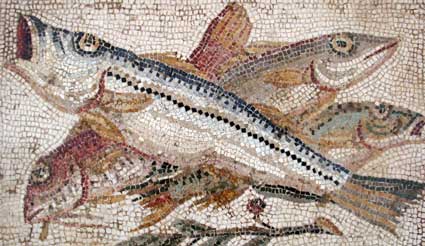This is a dialog between Domitia Iusta and her slave. It shows really well how the diet in Roman age was. In the shopping list which Domitia reads to Lesso, we will see what kind of food the Romans used to eat in a banquet, as the one that Domitia is making.
The Romans usually divided their diet in three meals: ientaculum (breakfast), prantium (lunch) y cena(dinner). They did not pay too much attention to the first meals of the day, which were not much hearty, on the contrary the dinner represented the main meal. It was the time in which the Romans met with all the family or friends at the end of a day’s work.
The majority of the Roman people ate a mixture of flour boiled, called pulmentum, which was sometimes served with vegetables and rarely with meat, because that was too expensive. On the contrary, the Romans’ inclination for the delicate gastronomy was only possible for the upper class. They made great banquets where a wide variety of food was served, such as happens in the Lucius Antonius Niger’s house in Valencia.

The ientaculum was served in the morning, from 8 am to 9 am. It could consist of bread dipped in wine, following a Grecian custom, the leftovers from the previous dinner or olives, eggs and cheese.
They ate the prantium around midday. It consisted of a snack which was eaten outside home during the lunch break. It was only for the luckiest people who could afford it, and was sold by hawkers at the public place. When the Romans had lunch at home, they always ate the leftovers from the previous day. Therefore, we are talking about cold dishes to eat standing up.
The dinner’s hour began gradually to move from the afternoon to the evening. The meal could consist of one dish when they ate alone (domicenium), or it could become a great meeting when they ate with the friends (convivium). In this case there was a strict order of dishes’ sequence, which sometimes was exchanged to surprise the guests, and the number of these dishes had to be at least three-course meal (fercula).
The convivium started with a hearty and stimulating appetiser, called gustatio. The diners drank theFalernum wine together with the tasting of eggs, seafood, mushrooms, cardamom and vegetables. Then, there were dishes of meat and fish followed by roasts of game meat and refined dishes (mensa prima ocaput cena).
Finally, was served a dessert and also some fresh and dried fruits. Sometimes it was called secunda mensa.
The Romans put in their meal much spices, aromatic herbs and several condiments, among the most important of them stands out the garum..

What the garum was?
The food product that we know with a name of “garum” is the result of the fermentation of anchovies, sardines and mackerels entrails with salt and several aromatic herbs. It was the most mentioned condiment in the Marco Gavio Apicio’s recipe book. He was a Roman gastronome who lived in the Augusto and Tiberio age and he is considered to be the writer the De re coquinaria cookery book.
In conclusion, the garum seemed to combine well with wine and vinegar, and even in some of the recipes it is advised to replace the salt by it. Therefore, we could say that it was a “universal condiment".
